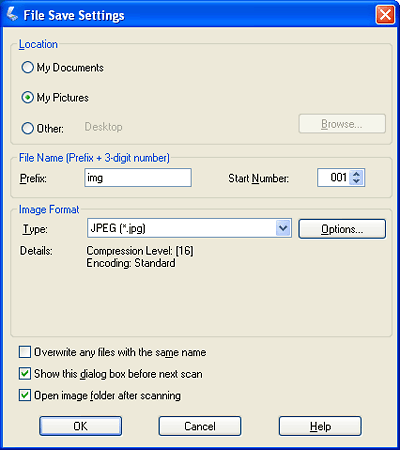![]()
Reference Guide
| Index | Help | Safety | ||||||||
| Contents | Glossary |
|
||||||||
|
|
|
|||||||||||||||||||||||||||||||||
How To
To save scanned images without editing them in an application, start EPSON Scan directly. After scanning images, the scanned images are automatically saved as files in the folder specified in the File Save Settings dialog box. This operation can be set up as follows:
 |
Do one of the following to start EPSON Scan. |
For Windows users:
Double-click the EPSON Scan icon on your desktop
Or, select
or Start > All Programs or Programs > EPSON Scan .
For Mac OS X users:
Click the EPSON Scan icon in the Applications folder.The EPSON Scan window appears.
|
|
Click the  File Save Settings button to the right of the Scan button. . File Save Settings button to the right of the Scan button. . |

| Note: |
|
|
|
Specify the folder in which you want to save your scanned images. Click the My Documents or My Pictures radio button (Windows XP or 2000), or the Documents or Pictures radio button (Windows Vista or Mac OS X). If you want to change the default location, click Other, then click Browse (for Windows) or Choose (for Macintosh) and select a desired folder. If you want to save your image on the desktop, simply click Other. |
|
|
Specify a file name with an alphanumeric character string (prefix) and a 3-digit number (start number). |
If you want to change the file name, type an alphanumeric character string in Prefix and select a start number. The name of a file is generated using a combination of the prefix and number specified here.
| Note: |
|
|
|
|
|
Select a file format from the following table. Depending on the selected file format, the Options button may be available so that you can make detailed settings for scanned images. |
|
Format |
Explanation |
|
BITMAP (*.BMP) (Windows only) |
A standard image file format for Windows. Most Windows applications including word processing applications can read and prepare images in this format. |
|
JPEG (*.JPG) |
A compressed file format. The compression quality can be selected. The JEPG format enables relatively high compression ratio. However, the higher the compression ratio is, the lower the image quality becomes. (Note that the original data cannot be restored.) In addition, the quality deteriorates every time the data is saved. The TIFF format is recommended in cases where modification, retouch and like are required. |
|
Multi-TIFF (*.TIF) |
A TIFF format where multiple pages are saved to the same file. When you scan documents using the Automatic Document Feeder, they are all stored in the same file. (With other formats, each document is saved in a separate file.) However, to open the Multi-TIFF files, you need an application supporting this format. |
|
PDF (*.PDF) |
A document format that is independent of platforms. To use PDF documents, you need Adobe Reader® or Acrobat®. When you scan documents using the Automatic Document Feeder, multiple pages are saved to a single file. When you save color or grayscale images in PDF, you can select a compression quality. |
|
PICT (*.PCT) (Macintosh only) |
A standard image file format for Macintosh. Most Macintosh applications including word processing applications can read and prepare images in this format. |
| PRINT Image Matching II JPEG (*JPG) or TIFF (*.TIF) | A file format that includes PRINT Image Matching II data for enhanced quality and a wider color range. Print Image Matching II compatible printers can then print this data for brilliant, true-to-life results. (PRINT Image Matching data does not affect the way the image displays on the screen.) Available in JPEG or TIFF format. |
|
TIFF (*.TIF) |
A file format created for exchanging data among many applications, such as graphic and DTP software. When scanning black & white images, you can specify the compression type. |
|
|
Click OK. |
EPSON Scan starts scanning.
|
|
The scanned image is automatically saved in the specified location. |
If the Open image folder after scanning check box in the File Save Settings dialog box is selected, Windows Explorer (Windows) or Finder (Macintosh) automatically opens the folder where the scanned image is saved when EPSON Scan finishes scanning.
 Previous |
 Next |
| Version 1.00E, Copyright © 2003, SEIKO EPSON CORPORATION |